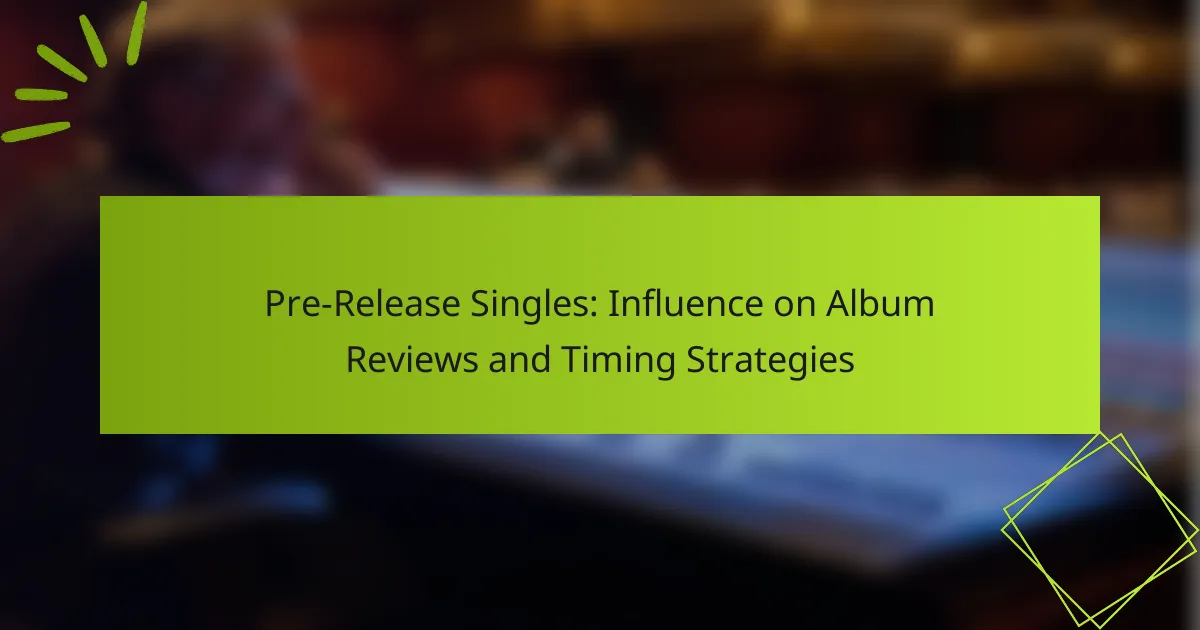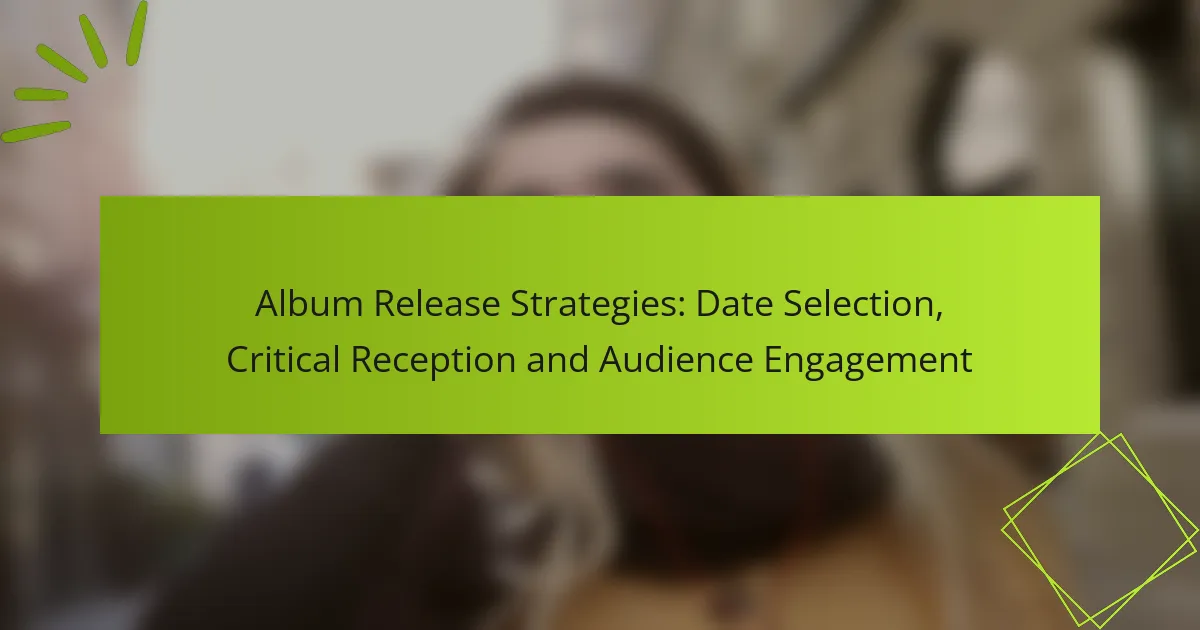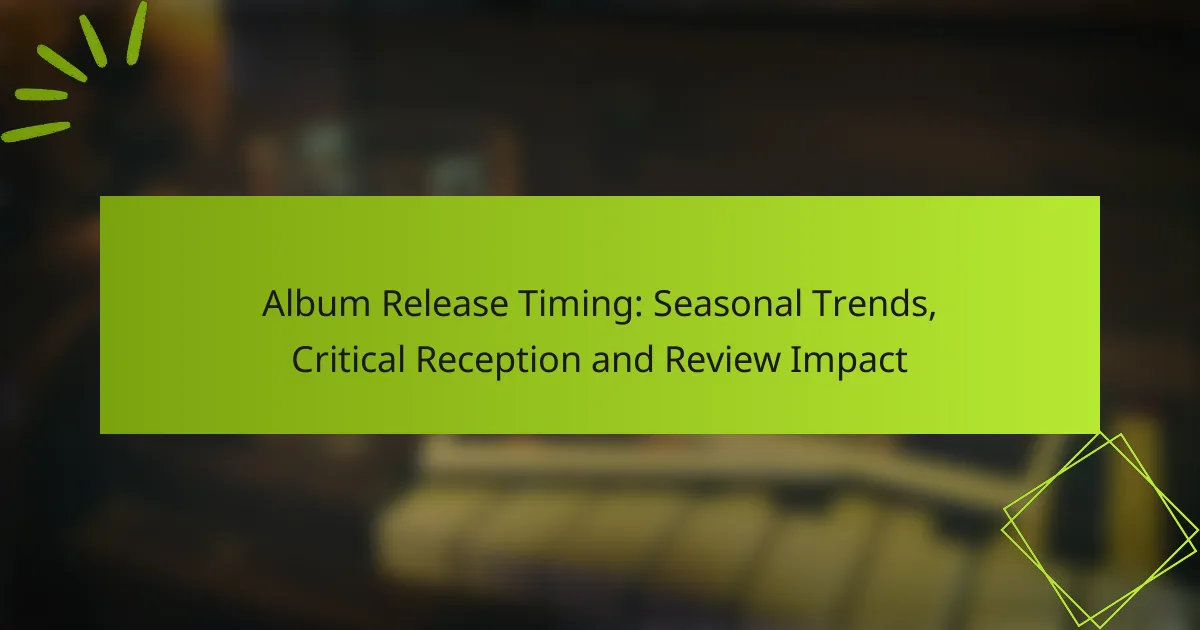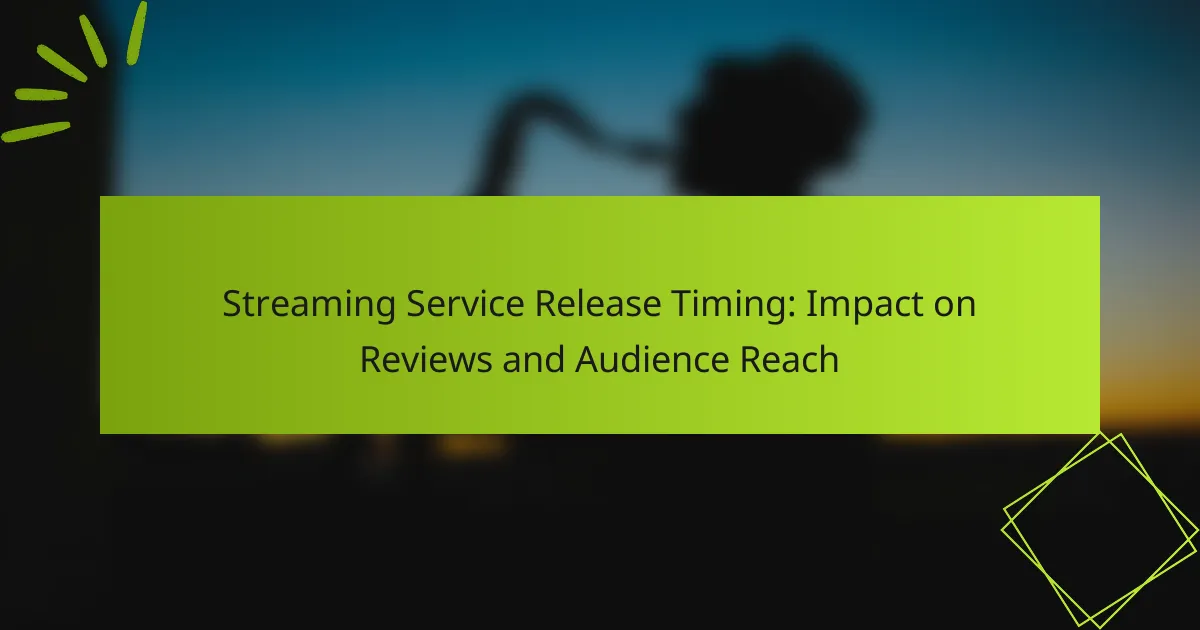Pre-release singles play a crucial role in shaping album reviews by establishing expectations and influencing critics’ initial perceptions. By offering a glimpse into the album’s sound and direction, these tracks can significantly affect how reviewers evaluate the complete work. Additionally, strategic timing in releasing these singles can enhance their impact, creating anticipation and context that ultimately influences the album’s reception.
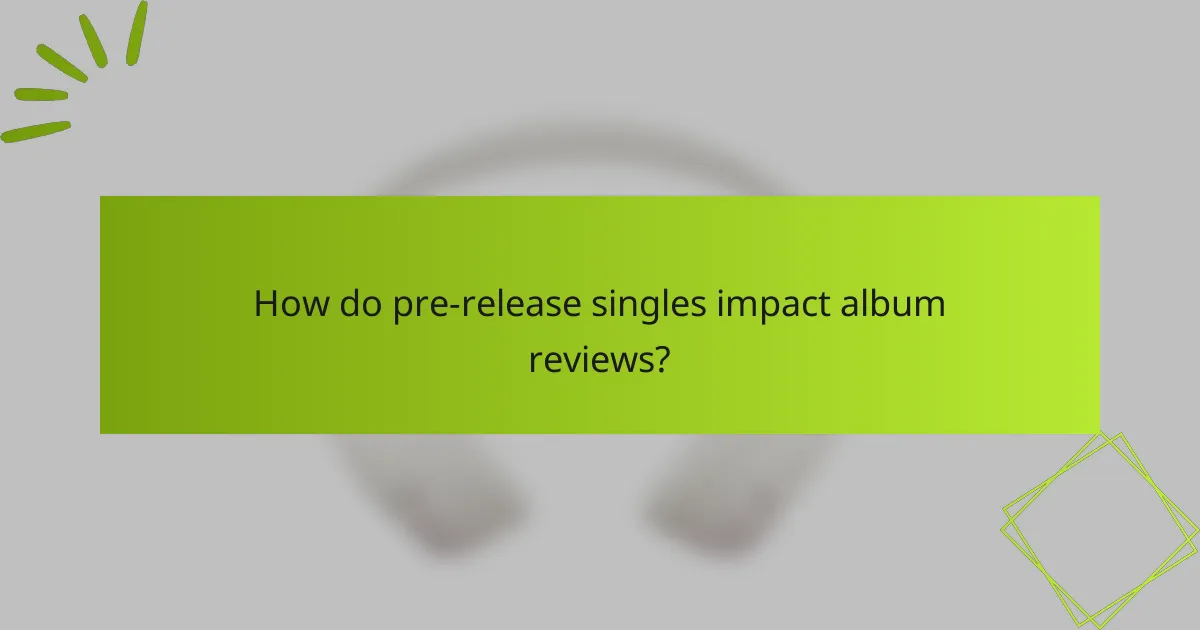
How do pre-release singles impact album reviews?
Pre-release singles significantly influence album reviews by setting expectations and shaping critics’ initial impressions. These tracks often serve as a preview of the album’s overall sound and direction, impacting how reviewers approach their evaluations.
Increased anticipation among critics
When an artist releases a pre-release single, it generates excitement and anticipation among music critics. This heightened interest can lead to more in-depth analysis and scrutiny of the upcoming album, as critics often look for thematic and stylistic continuity between the single and the full project.
For example, if a single showcases a new sound or lyrical depth, critics may be more inclined to explore these elements further in their reviews, potentially leading to a more favorable reception if the album delivers on those expectations.
Influence on review scores
Pre-release singles can directly affect the scores that albums receive from critics. A strong single may lead to higher initial ratings, as reviewers might be predisposed to view the album positively based on the single’s success. Conversely, a disappointing single can lower expectations and result in harsher critiques.
For instance, if a single is well-received and resonates with audiences, it may set a benchmark that the full album is expected to meet or exceed, influencing the final review scores significantly.
Shaping public perception
The release of pre-release singles plays a crucial role in shaping public perception of an album before its official launch. Fans often form opinions based on these singles, which can lead to heightened discussions and buzz on social media platforms.
Moreover, if a single becomes a hit, it can create a positive narrative around the album, encouraging more listeners to engage with the full project upon its release. This can be particularly effective in driving sales and streaming numbers, as fans are more likely to support an album that has already captured their interest through its singles.
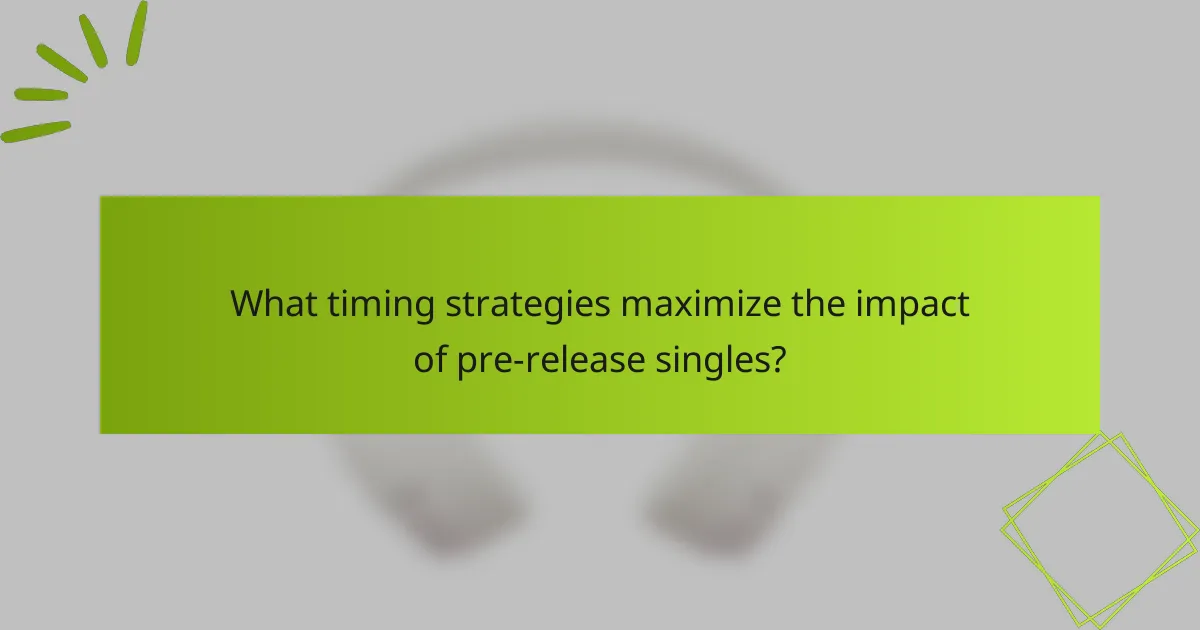
What timing strategies maximize the impact of pre-release singles?
Effective timing strategies for pre-release singles can significantly enhance their impact on album reviews and overall reception. Key considerations include the timing of the release relative to the album launch, seasonal trends in music consumption, and the implementation of strategic lead-up campaigns.
Release timing relative to album launch
Releasing singles too early may lead to diminished excitement by the time the album drops, while releasing them too late can miss the opportunity to build momentum. A common strategy is to release one or two singles about a month before the album launch, allowing enough time for promotion while keeping the audience engaged. This timing can create anticipation and ensure that the singles remain fresh in listeners’ minds.
Consider staggered releases for multiple singles to maintain interest over time. For instance, a first single can be released three to four weeks prior to the album, followed by another one or two weeks later. This approach can help sustain buzz and encourage pre-orders or streaming upon the album’s release.
Seasonal trends in music consumption
Music consumption often fluctuates with the seasons, impacting the effectiveness of pre-release singles. For example, summer months typically see higher engagement due to outdoor events and festivals, making it an ideal time for upbeat or party tracks. Conversely, fall and winter may favor introspective or holiday-themed songs, aligning with listeners’ moods during these seasons.
Artists should consider aligning their single releases with these seasonal trends to maximize reach and engagement. Analyzing past release data can provide insights into which times of year yielded the best results for similar genres or styles.
Strategic lead-up campaigns
Implementing a strategic lead-up campaign can significantly enhance the impact of pre-release singles. This may include social media teasers, exclusive previews, or behind-the-scenes content that builds anticipation. Engaging with fans through interactive content, such as polls or contests, can also create buzz and encourage sharing.
Additionally, collaborating with influencers or music blogs for early reviews or features can amplify reach. Consider creating a countdown to the album release, utilizing platforms like Instagram or TikTok to maintain momentum and keep the audience engaged leading up to the launch.

Which artists effectively use pre-release singles?
Many artists leverage pre-release singles to generate buzz and set the tone for their upcoming albums. This strategy not only engages fans but also influences album reviews by creating anticipation and context for the full release.
Billie Eilish’s strategic releases
Billie Eilish often employs a calculated approach to her pre-release singles, using them to build narrative and emotional depth. By releasing singles that reflect themes from her albums, she creates a cohesive listening experience that resonates with her audience.
For instance, her single “Your Power” was released ahead of her album “Happier Than Ever,” effectively setting the stage for the album’s exploration of personal struggles and societal issues. This strategy helps critics and fans alike to better understand the context of her work.
Taylor Swift’s album rollout tactics
Taylor Swift is known for her meticulous album rollout strategies, often releasing multiple singles before the full album launch. This approach allows her to showcase different facets of her music and engage her fanbase through various promotional activities.
For example, with her album “Midnights,” she released several singles that highlighted different themes and musical styles, creating a layered narrative that critics could analyze. Swift’s use of social media and fan interactions further amplifies the impact of her pre-release singles.
Drake’s single-first approach
Drake frequently adopts a single-first strategy, releasing tracks that serve as lead-ins to his albums. This method not only garners immediate attention but also allows him to gauge audience reactions before the full album drops.
His singles often dominate streaming platforms and charts, creating a strong foundation for the album’s eventual release. By focusing on catchy, radio-friendly tracks, Drake ensures that his music remains relevant and widely discussed, influencing early reviews and listener expectations.

What are the best practices for selecting pre-release singles?
Choosing effective pre-release singles is crucial for generating interest and shaping the narrative around an upcoming album. Best practices involve selecting tracks that connect with audiences, balancing commercial success with artistic vision, and leveraging data analytics for informed decisions.
Choosing tracks that resonate with audiences
Selecting tracks that resonate with listeners is essential for a successful pre-release strategy. Focus on songs that showcase the album’s themes and emotional depth, as these can create a stronger connection with fans. Consider conducting surveys or focus groups to gauge audience reactions to potential singles.
Additionally, look at past releases to identify which styles or messages have previously engaged your audience. This historical insight can guide your choices and help ensure the selected singles align with listener preferences.
Balancing commercial appeal and artistic integrity
Striking a balance between commercial appeal and artistic integrity is vital when selecting pre-release singles. While catchy hooks and mainstream trends can attract attention, it’s important to maintain the artist’s unique voice and vision. Aim for tracks that are both commercially viable and true to the artist’s style.
Consider releasing a mix of radio-friendly songs alongside deeper cuts that reflect the album’s artistic intent. This approach can satisfy both commercial expectations and the desire for authentic expression, appealing to a broader audience while preserving the artist’s integrity.
Analyzing streaming data for selection
Utilizing streaming data can provide valuable insights when selecting pre-release singles. Platforms like Spotify and Apple Music offer analytics on listener engagement, which can help identify which tracks are gaining traction. Look for metrics such as play counts, skip rates, and playlist placements to inform your decisions.
Additionally, consider demographic data to understand which songs resonate with specific audience segments. This data-driven approach can enhance the effectiveness of your single selection, ensuring that the chosen tracks align with current listening trends and preferences.

How do pre-release singles affect streaming metrics?
Pre-release singles significantly influence streaming metrics by generating initial buzz and driving listener engagement before an album’s official release. These singles can create anticipation, leading to higher streaming numbers and better overall performance on music charts.
Boost in initial streaming numbers
When an artist releases a single prior to an album launch, it often results in a surge in streaming numbers. This spike can occur within the first few days of release, sometimes reaching tens of thousands to millions of streams, depending on the artist’s popularity. A well-timed single can leverage social media and playlists to maximize its reach.
To capitalize on this boost, artists should consider releasing their singles strategically, ideally 4-6 weeks before the album drops. This timing allows for adequate promotion and listener buildup.
Impact on chart performance
Pre-release singles can significantly enhance an album’s chart performance. When these singles perform well on streaming platforms, they can help propel the entire album into higher chart positions upon release. For instance, a single that enters the top 10 can create momentum that benefits the album’s debut ranking.
Artists should monitor streaming and sales data closely to understand how their singles are performing. This information can inform promotional strategies and potential adjustments to release plans.
Long-term listener engagement
Releasing singles ahead of an album can foster long-term listener engagement by keeping fans interested and invested in the artist’s journey. Engaging content, such as behind-the-scenes videos or live performances, can further enhance this connection. Artists who maintain active communication with their audience can cultivate a loyal fan base.
To sustain engagement, consider releasing additional content related to the singles, such as remixes or acoustic versions, in the weeks leading up to the album launch. This approach can keep the momentum going and encourage listeners to explore the full album once it is available.
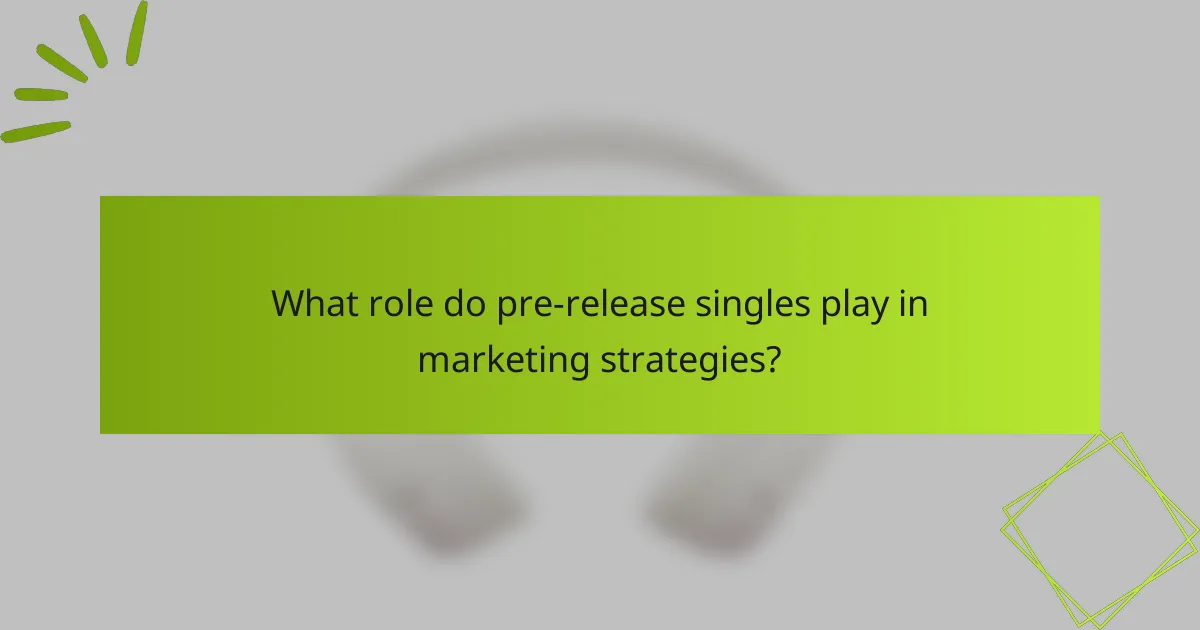
What role do pre-release singles play in marketing strategies?
Pre-release singles are crucial in marketing strategies as they generate buzz and anticipation for an upcoming album. By releasing one or more singles before the album launch, artists can engage their audience, create a narrative, and drive sales.
Building a narrative around the album
Pre-release singles help establish a narrative that connects the songs and themes of the album. By strategically selecting singles that reflect the overall message or story, artists can guide listeners’ expectations and enhance their emotional investment.
For example, if an album explores themes of resilience, an artist might release a single that showcases a powerful, uplifting message. This approach not only captivates the audience but also sets the tone for the entire album.
Additionally, artists can use music videos and social media to further develop this narrative, providing visuals and context that deepen the listener’s understanding and connection to the album.
Timing strategies for releasing singles
The timing of pre-release singles is essential for maximizing impact. Releasing a single too early may lead to diminished interest by the time the album drops, while waiting too long can miss the opportunity to build momentum.
A common strategy is to release the first single several weeks to a couple of months before the album launch, followed by additional singles spaced out to maintain engagement. This staggered approach keeps the audience excited and allows for ongoing promotion.
Artists should also consider aligning single releases with significant dates, such as holidays or events, to leverage increased media attention and listener engagement. For instance, a summer anthem might be best released in late spring to capitalize on seasonal vibes.
